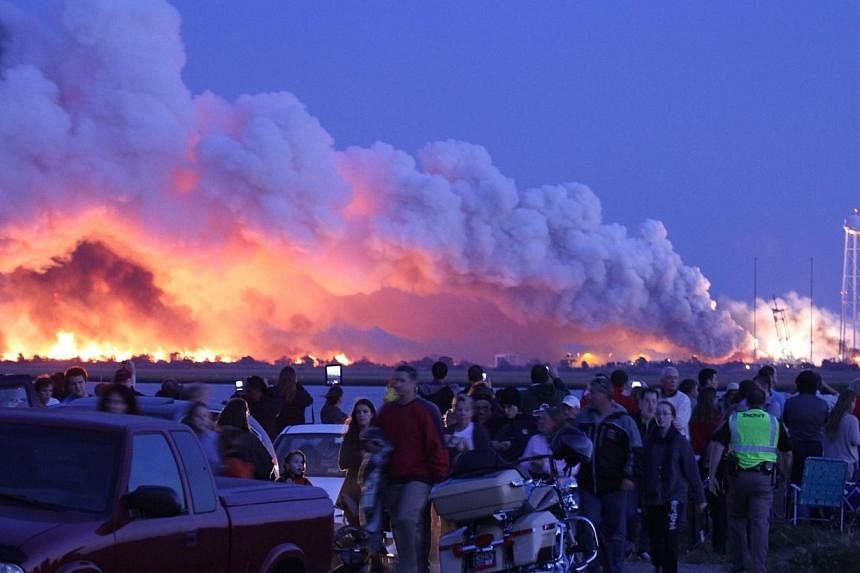An unmanned rocket by the United States' National Aeronautics and Space Administration (Nasa) exploded after taking off from its launch pad on Tuesday (Wednesday morning Singapore time).
The 14-storey Antares rocket was supposed to carry supplies and secret equipment from Virginia to the International Space Station, but combusted in flames just seven seconds after lift-off.

Although no one was injured and the cause is still unknown, this latest mishap, along with the film Gravity starring Sandra Bullock and George Clooney, brings to mind other space ventures that have ended tragically.
Here are five of the worst fatal accidents in space history.

As Nasa was racing to land the first man on the moon, this was the first fatal accident in space agency's 56-year history.
On January 27, 1967, three astronauts died during a routine ground test of the Apollo 1 capsule.
During the simulated countdown to lift-off, a cry of "fire!" was heard over the communications channel.
Virgil "Gus" Grissom, 40, Edward White, 36, and Roger Chaffee, 31, suffocated when an electrical spark ignited a blaze which engulfed their pressurised cabin.
Investigations pointed to several oversights, including the use of pure oxygen in the cabin which fueled the flames, flammable Velcro strips and an inward-opening hatch which trapped the astronauts.
The incident caused an 18-month shutdown of the Apollo moon programme, but prompted design and procedural changes for future missions, according to Space.com.
Said space historian James Hansen: "If the fire hadn't happened, a lot of people say we wouldn't have successfully reached the moon."

This was the first human fatality in a space mission, set against the backdrop of the competitive Space Race between the Soviet Union and the United States during the Cold War.
Soviet mission Soyuz 1 launched on April 23, 1967, but was plagued with multiple mechanical issues, such as the solar panels not unfolding, and the vessel experiencing stability problems.
The faulty capsule's parachute failed to open properly during re-entry on April 24, causing it to crash into Russian soil and killing 40-year-old cosmonaut Vladimir Komarov on impact.
In the 2011 book, Starman - The Truth Behind the Legend of Yuri Gagarin, authors Jamie Doran and Piers Bizony claim that during Komarov's last communications with gound control, the cosmonaut "cried in rage" at the engineers he blamed for the glitch-ridden spacecraft.

When the Soviet Soyuz 11 spacecraft landed safely after re-entry on June 30, 1971, recovery teams were shocked to find the three-man crew dead in their seats.
Georgi Dobrovolski, Viktor Patsayev and Vladislav Volkov had returned from a three-week stay at the Salyut 1 space station with dark-blue splotches on their faces and blood dripping from their ears and noses.
Investigations showed that a breathing ventilation valve had ruptured in space, causing a pressure leak and asphyxiating the cosmonauts.
The craft still landed nonetheless, as the capsule ran an autopilot re-entry programme.
These are considered first and only human deaths in space, as other fatalities have occured within Earth's atmosphere.

The space shuttle Challenger was dubbed by Space.com as one of Nasa's greatest triumphs, but also its "darkest tragedy".
It was the second shuttle to reach space in April 1983, and successfully completed nine milestone missions.
During its 10th launch on January 28, 1986, however, Challenger burst into flames on live television 73 seconds after taking off.
The explosion killed the entire crew of seven, including the first teacher headed for orbit, Christa McAuliffe. She was slated to teach lessons from space, and the highly-anticipated launch had attracted millions of viewers, including school children.
The other victims were commander Francis "Dick" Scobee, pilot Michael Smith, mission specialists Judith Resnik, Ellison Onizuka, Ronald McNair and payload specialist Gregory Jarvis.
In June that year, a presidential commission on the accident found that the O-ring seals in the right solid-rocket booster failed in the cold temperature, causing the booster to rupture and explode.
The tragedy grounded the US shuttle programme for more than 20 years.
The Challenger incident was referenced in Beyoncé's song XO. In the first six seconds Nasa public affairs officer Steve Nesbitt can be heard saying about the explosion: "Flight controllers here looking very carefully at the situation. Obviously a major malfunction."
The pop and R&B superstar received flak from Nasa and some members of the public, who felt that her reference was insensitive and trivialised the disaster.
5. Columbia, 2003

After a 16-day research mission in Earth's orbit, the crew on board Nasa's Columbia perished when the space shuttle disintegrated upon re-entry on February 1, 2003.
The seven who lost their lives were mission commander Rick Husband, pilot William McCool and mission specialists Kalpana Chawla, Laurel Clark, David Brown, payload commander Michael Anderson and payload specialist Ilan Ramon - Israel's first astronaut.
Investigations linked the mishap to foam from the fuel tank's insulation falling off and hitting Columbia's left wing during its take-off on January 16. This left an undetected hole in the wing, allowing hot gas to penetrate and cause internal damage.
The next year, then-US president George W. Bush announced the retirement of the shuttle program.
Sources: Space.com, Nasa, BBC, Reuters, The Telegraph


